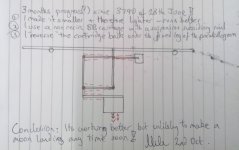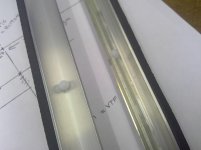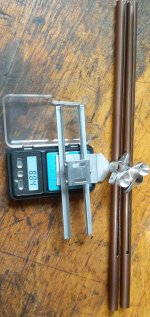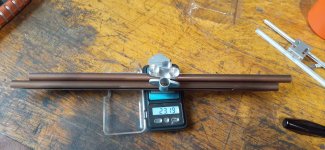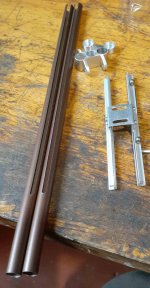Yes the Virtins is a complete measuring package including Scope, signal generator and a host of other functions. The measurement features look pretty good and include Wow & Flutter.
I have all the other test equipment so REW works for me as a spectrum analyser. If REW had markers it would be almost perfect for what I use it for.
I have all the other test equipment so REW works for me as a spectrum analyser. If REW had markers it would be almost perfect for what I use it for.
Hi Mike,
Depends on how far you want to go with DIY, for the most part a scope, signal generator and DMM are all that's needed.
My entire system including speakers is DIY, and being a retired technician I already had a heap of test equipment I have gathered over the years. A spectrum analyser is handy to see the signal in frequency domain. This makes identifying unwanted artifacts easier.
Most scopes these days have FFT spectrum analysers but the Solo/REW is far superior to any scope FFT even my Tektronix TDS3000.
Depends on how far you want to go with DIY, for the most part a scope, signal generator and DMM are all that's needed.
My entire system including speakers is DIY, and being a retired technician I already had a heap of test equipment I have gathered over the years. A spectrum analyser is handy to see the signal in frequency domain. This makes identifying unwanted artifacts easier.
Most scopes these days have FFT spectrum analysers but the Solo/REW is far superior to any scope FFT even my Tektronix TDS3000.
Hi Mike,
Depends on how far you want to go with DIY, for the most part a scope, signal generator and DMM are all that's needed.
My entire system including speakers is DIY, and being a retired technician I already had a heap of test equipment I have gathered over the years. A spectrum analyser is handy to see the signal in frequency domain. This makes identifying unwanted artifacts easier.
Most scopes these days have FFT spectrum analysers but the Solo/REW is far superior to any scope FFT even my Tektronix TDS3000.
A difficult question, when i made my speakers i didn't know i needed a mic or REW, and i didn't know i would make a radial arm when i bought my Origin live kit......
So, for now!, this is just about optimising design and build of the arm/turntable................
The Solo is a high quality USB sound card. It's FR and noise floor are far superior to any inbuilt sound card.
The Solo is the input device. You do not use the microphone, feed the output of the phono pre directly to the line input of the Solo. Open REW RTA. Then it's a matter of setting up various parameters in RTA to do the measurements.
If you decide to go down this route I would be happy to guide you through the process.
Can i try feeding line out from the preamp into the PC soundcard (microsoft surface) before buying solo? mike
Warrenjon
The Sonos is superior in noise and THD , but for Mikes needs this is of no importace. As I see it he needs to know something about resonanses and mistracking, not ultimate low noise and THD. A standard soundcard will be quite sufficient for that as a start...My 25 c..
The Sonos is superior in noise and THD , but for Mikes needs this is of no importace. As I see it he needs to know something about resonanses and mistracking, not ultimate low noise and THD. A standard soundcard will be quite sufficient for that as a start...My 25 c..
If you have a line input , this would be better. You can try the mic input, but be sure to turn down the vol. of your preamp to a very low level..Can i try feeding line out from the preamp into the PC soundcard (microsoft surface) before buying solo? mike
Hi Eduard -
skilled kraftsmen have always been essential for progress, because it is also from their practical experience, as well as from research, that came many of the ideas that changed the world.
As a hobbyist, the long effort of learning to use decently a lathe has greatly increased my respect and consideration for precision mechanics in general, and machinists in particular.
Much less instead for those who use old ideas claiming them as their own inventions, maybe changing just some ridiculous detail.
carlo
skilled kraftsmen have always been essential for progress, because it is also from their practical experience, as well as from research, that came many of the ideas that changed the world.
As a hobbyist, the long effort of learning to use decently a lathe has greatly increased my respect and consideration for precision mechanics in general, and machinists in particular.
Much less instead for those who use old ideas claiming them as their own inventions, maybe changing just some ridiculous detail.
carlo
Carlo, Edouard,
You both build beautifully, the envy of someone like me, i like to think i am content if it just works, but truth is i would like it to look great as well, just don't have the skills and equipment for that..........
As for "borrowing" other peoples ideas, that's the benefit of these threads, certainly where i got all my basic info from, and yes its important to acknowledge that as well.
Now i have something basic that works i am openly asking others to suggest ideas on how to improve it and hope to get some great input as well.
I believe the science in genetics is largely done this way, its open book to a great extent and those involved cooperate and present ideas openly at conferences etc, to gain feedback and stimulate others, that's how it makes such quick progress........
You both build beautifully, the envy of someone like me, i like to think i am content if it just works, but truth is i would like it to look great as well, just don't have the skills and equipment for that..........
As for "borrowing" other peoples ideas, that's the benefit of these threads, certainly where i got all my basic info from, and yes its important to acknowledge that as well.
Now i have something basic that works i am openly asking others to suggest ideas on how to improve it and hope to get some great input as well.
I believe the science in genetics is largely done this way, its open book to a great extent and those involved cooperate and present ideas openly at conferences etc, to gain feedback and stimulate others, that's how it makes such quick progress........
Raining heavily today and i had plans to be outside, so reverted to looking back and reading the thread to settle my mind on what to try next.
I assessed progress in the last 3 months on a very small piece of paper, the WPB is full of wrong ideas and so on............
Mike
I assessed progress in the last 3 months on a very small piece of paper, the WPB is full of wrong ideas and so on............
Mike
Attachments
Mike,
Why move the whole parallelogram, when you can fix it on the leg and move only the cartridge with light rails on 4 balls without extra levers?
i find this whole area intriguing and when i looked at Carlos wonderful LC I thought the opposite, why is the cartridge having to move the whole arm rails etc and all its parts (in warp) before the parallelogram comes into effect on the end of a long lever? why not leave the whole arm set up static and mount the parallelogram at the cartridge? it reduces moving mass and torques.
Carlo can probably best comment in detail because he has a deeper perspective on both these alternative solutions.
Which is better? - equally i dont know!
Mike
Look at post #4098 to see what carlo says about this.Mike,
Why move the whole parallelogram, when you can fix it on the leg and move only the cartridge with light rails on 4 balls without extra levers?
The other thing is the parallelogram is a much smaller structure than the rail (and double rails) so for me it makes sense to make the big structure solid and non moveable and the comparable smaller (and it can be reduced in size even more) parallelogram the floating part.
Mike,
Look at the third photo. Rails, shell, and cartridge all together weigh no more than 30 grams, and, when playing, the pressure on the balls does not exceed the downforce of 1-3 grams.
Edouard, i followed reading by intuition, mulling over and thinking, with a big dose of advice to get to here, made lots of silly errors already in my 3 month journey and i am sure i will make many more.
I don't see this as right or wrong, just this is what i am doing and find easy to execute with hand tools only. it may be a false route, i don't know.
I expect that your solutions and numerous other routes produce excellent (probably better) results, LC like yours absolutely clearly being in that group, and wonderfully executed as well. i cannot do that standard of work though.
BTW, downforce (total) on the balls, must be weight of everything stylus side of the balls -no? action and reaction? the cartridge weighs ~6 grams alone?
Maybe i will be back there one day? - who knows? - meanwhile i am having fun doing this and have found some good friends giving me advice, good to have your inputs as well, thanks
Best
Mike
Look at post #4098 to see what carlo says about this.
The other thing is the parallelogram is a much smaller structure than the rail (and double rails) so for me it makes sense to make the big structure solid and non moveable and the comparable smaller (and it can be reduced in size even more) parallelogram the floating part.
Evening Karsten, i am looking forward to Carlos evolution when its finished and playing records to see what more ideas i can borrow from it, sure to be some great stuff there!
mike
Thinking of improving my rails i picked up my original glass set thinking them probably better than the aluminium V, i clipped an aluminium V to one side and placed Delrin 5mm on each.
Then i lifted the end to see which moved first.
Repeated result, the aluminium side moved first every time, sometimes at roughly half the angle that started the glass side...
Tried different places along the rails as well etc etc, same thing each time.
So i will now seek anodised aluminium to compare next
Mike
Then i lifted the end to see which moved first.
Repeated result, the aluminium side moved first every time, sometimes at roughly half the angle that started the glass side...
Tried different places along the rails as well etc etc, same thing each time.
So i will now seek anodised aluminium to compare next
Mike
Attachments
Mike.
Very interesting Edouard, and what is the total with the other parts, cartridge etc?
I don't know what's more important the weights or the levers, perhaps something else, Carlo frequently has interesting thoughts on these, far more perceptive than mine. Clearly stylus drag around the parallelogram hinges is significant?
End of the day, if it sounds great then it is!
mike
- Home
- Source & Line
- Analogue Source
- DIY linear tonearm
